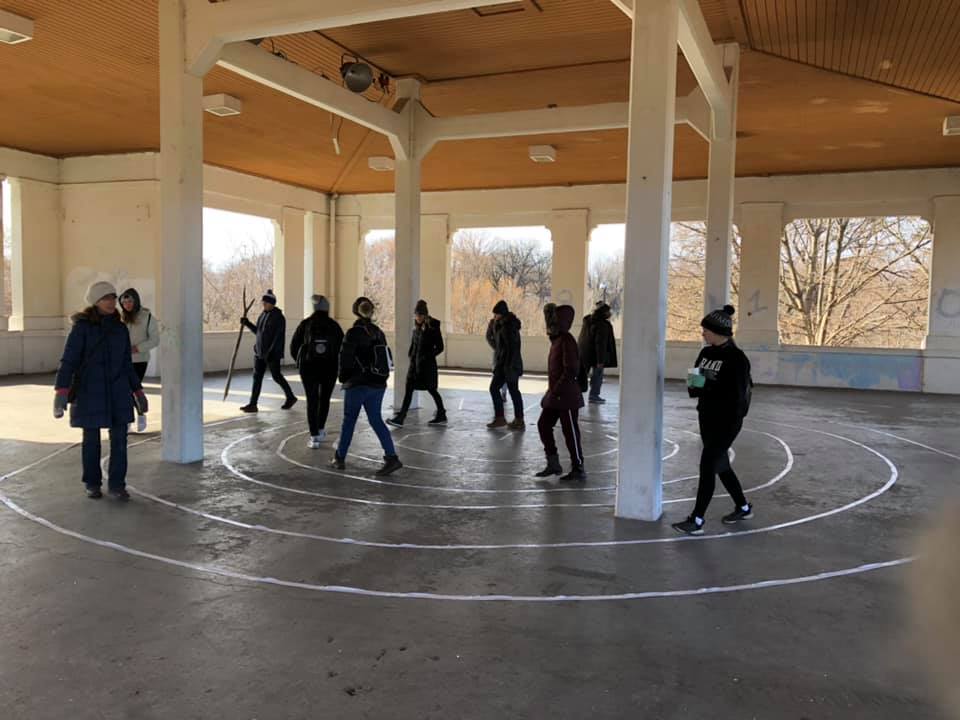The academic field of English literature is disappearing for lack of workers: fewer students are declaring English as a major, causing literature faculty to pick up work in other disciplines. But perhaps our field is merely going through a fallow phase. Maybe we are being called to push aside, for the time being, our books and papers so as to enter a real field full of grasses, dignified weeds, sunlight and wind. Look up from the book you are reading and live it instead! Set forth on a pilgrimage and learn to implement a whole range of bookish practices: read the world, follow the storied lives of others, and, perhaps most important, tell a tale of your own. We must do this, not to prove the utility of our discipline (useless knowledge is something to celebrate), but to break the path forward for human beings, who are too busy to even consider whether they are following a path that truly pleases them. We book-lovers are the obvious guides, because we know how to burrow through layers of meaning, we trust enough to follow a narrative line, and we expect epiphany because we’ve learned to be at home in metaphor.

“Walking is boring,” said one of the less interested freshmen in the trial run of a first-year experience course titled, “The Literature and Practice of Walking.” He prefers running because you don’t have time to think on the fast track to law school and a daily grind for which he plans to wear a suit. He scoffed at Thoreau’s advice to mistrust any endeavor that requires new clothes. Pity the student who runs from boredom. “Life, friends, is boring,” writes poet, John Berryman in Dream Song 14; yet, “we must not say so,” because “the sky flashes, the great sea yearns, / we ourselves flash and yearn, / and moreover my mother told me as a boy / (repeatingly) ‘Ever to confess you’re bored / means you have no / Inner Resources.’” If life is fundamentally boring (and many writers admit that it can be), then young people must be allowed to feel that boredom in their bones (“Go read a book” was my Grandmother’s answer to all such complaints). Yawning afternoons and wide deserts of time push children to meet their imaginations and discover their own questions, interests, yearnings. Instead, today’s parents give kids phones and tablets, plug them into dvds or any number of devices loaded with the quick fixes of Facebook, apps, likes, emojis, and personal avatars that distract them from soul-searching or the more updated term, “self-hacking.” No wonder that in a much-discussed scientific study, most people chose to self-administer electric shocks than to sit quietly alone in a room for six minutes with only their thoughts. Evidently, what’s inside us is not merely boring but so distressing or terrifying that we’d rather self-harm.
Close the book, whatever book you happen to be reading, and step over the threshold into the world. Smell the air. It’s autumn. A single leaf falls. The sunlight burns through leaves the color of flame. God, is that you speaking? Every walk can be a pilgrimage and every walker a saunterer, and by Thoreau’s etymology that means she must walk as if leaving husband, child, home behind for Sainte Terre. Children would point at the medieval pilgrims wandering the landscape, shouting, “there goes a Sainte Terre-er” or saunterer. Any walk walked in this spirit becomes a pilgrimage because we uproot ourselves and head off empty handed and without supplies or protection into the world, unplugged … hence without artificial stimulants. We go into terra incognita, the wild, the steppe, the ruined neighborhoods of Flint, the gray days of November to find something to love, something to yearn for and cling to. We don’t know when we set out what that thing will be, but what I have learned is that words spoken by the world in a language with rain in it, dirt dangling from it, … is necessary for the solitary walker to discover her natural resources of desire. We yearn in response to the voices of the world. “I would build my cabin at Thread Lake in Flint,” wrote one of my students, “there is a sadness there that resonates with the depression in my own heart.” Another student repeats the class walks on his own, searching and searching in the mist for peace.
The Hebrews travelling from slavery in Egypt to the promised land offer a paradigm for those of us drawn to fierce landscapes. Instead of taking them by the quickest route, God leads them the roundabout way through the wilderness where there is little water and less food for forty years! Why? So that they may develop desire. So that they may figure out for themselves where they are traveling to. So that they may experience their own inner resources and know that they can and want to be a holy nation. They have to experience the flatness and the emptiness of reality to tune their ears to the voice of God. An example: they walked through the Red Sea as if on dry land. God piled the waters up on each side of them, and when they saw the Egyptians dead on the seashore and grasped the great work of the Lord, they believed and burst into song celebrating a God of steadfast love. They sang and they danced, but this ecstasy of love didn’t last. What followed was a dry period. Into the wilderness where the little water there was was bitter. Questions followed. What shall we drink? What shall we do? What is the way? Help, help. The immediate problem is solved when God shows Moses a piece of wood to sweeten the water, but the deeper problem is that their minds and spirits need to be active so that physical hardship doesn’t weigh them down. What did God do? He gave them a statute (rabbis think that it is the injunction to keep the Sabbath), and he adjures them to “listen carefully to the voice of the Lord your God.” The statute is a mental plaything, but love is the answer, love manifested in listening. Does God still speak to people today? He is not Siri. You cannot self-select whether His voice is male or female, soft or loud; and you cannot choose His accent. You must wait, longing for intimations of relationship. “I don’t know what I am passionate about,” writes another student, searching for purpose. She will make the pilgrimage across Flint with my first-year experience class and perhaps find an answer to her question. It (whatever “it” is) is solved by walking. Walk out into the world and listen. “Then,” the Exodus narrative tells us the Hebrews “came to Elim, where there were twelve springs of water and seventy palm trees; and they camped there by the water.” Not the land flowing with milk and honey—not yet—but heaven on the way.
Pilgrimage: falling into a story and bringing it to life
I had long longed to go on pilgrimage, secretly knowing that I needed to find my own source of life and motive for song. I’d been a devoted teacher, wife, and mother for more than twenty years, and I wondered what it would feel like to saunter away into the world unencumbered and alone. Although I carried no actual books, I knew I needed words to find myself; and that’s why pilgrimage was important to me. Words ignite the mind and imagination, and when we go on pilgrimage, we fall into a story that we must bring it to life in our own idiosyncratic way. The muse of our walk is usually a saint or a place that is holy because of its associations with the saint. Because the walk follows sites important in the saint’s life, the route, itself, has a textual quality. This past summer I walked Saint Cuthbert’s Way from Melrose, Scotland, to the Holy Island of Lindisfarne. The path is not ancient; it was created three decades ago, and it links places and terrain significant to Saint Cuthbert. It begins fittingly at Melrose. The abbey (in ruins now) is where Cuthbert entered monastic life and began his ministry, walking and teaching in villages scattered along the borderlands. Eventually he accepted the bishopric of Lindisfarne but, throughout his life, endured the ebb and flow of a desire to withdraw from pastoral duties altogether and live with the sea birds and beasts in the wild of a hermitage on the tiny island of Farne.
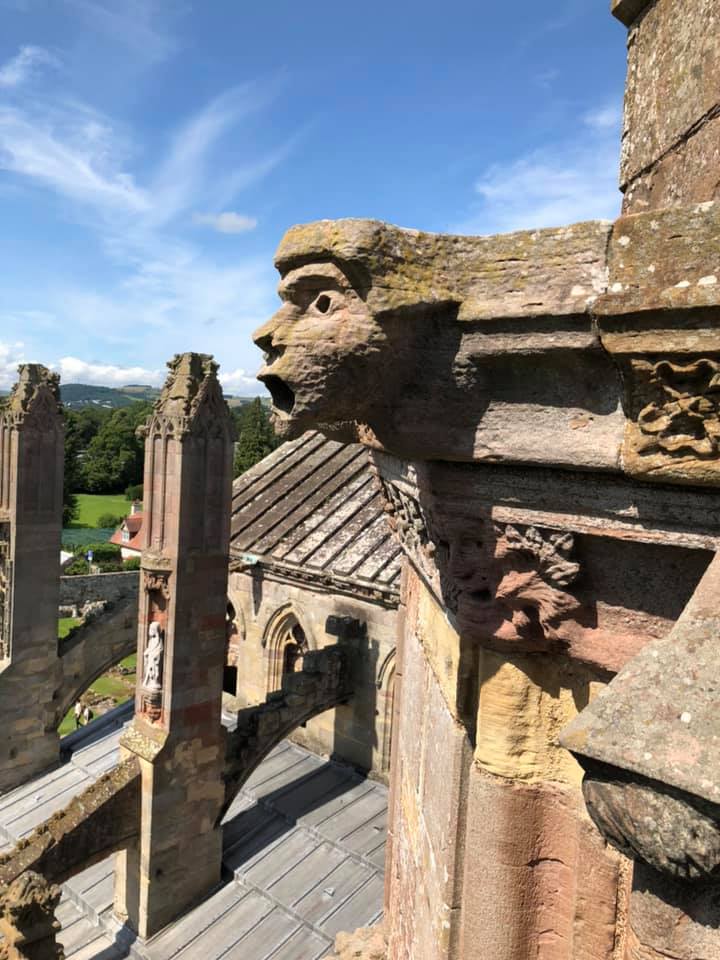
To prepare for my pilgrimage, I’d read two early biographies—one by an anonymous monk in Cuthbert’s community and the other by the first English historian, the Venerable Bede. I was, therefore, familiar with stories that have become iconic: Cuthbert’s vision of Aidan’s soul ascending; Cuthbert’s study of John’s gospel with his friend, the Abbot Boisil, who was dying of plague; Cuthbert’s ministering to an angel; his unconcern about food while walking great distances; the ways that animals—eagles and otters—tended to his needs; and, finally, his setting off for Farne in a December storm to be in hermitage before he died. I, too, was setting off alone in the storm of mid-life, shortly after my mother died. I wouldn’t call it a crisis, more like a need for clarification.
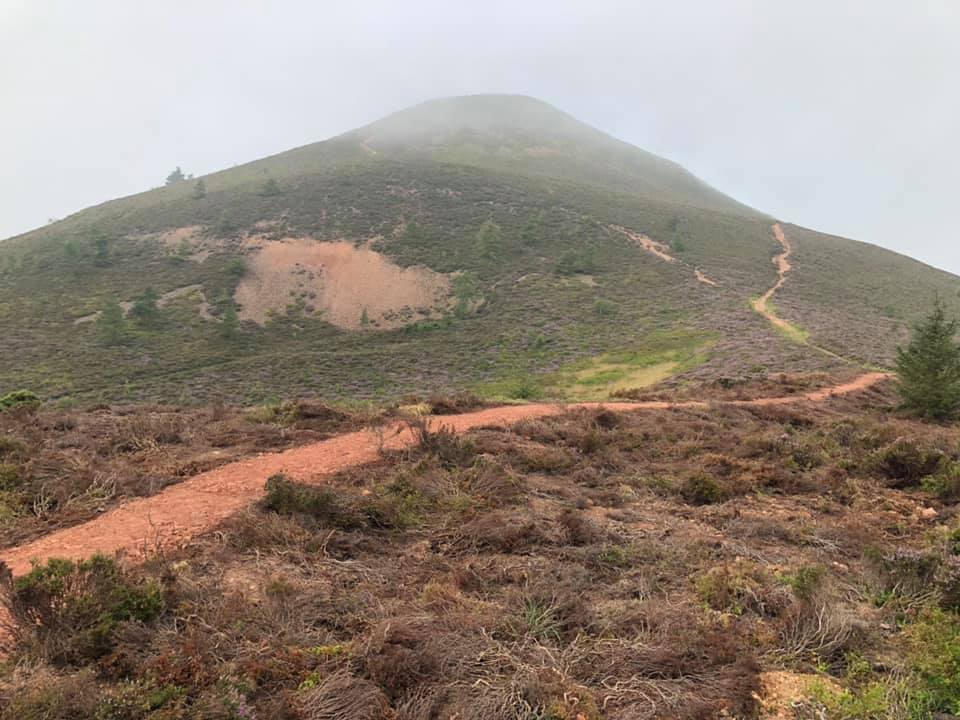
But once I clambered off the double-decker red bus in Melrose, deposited my heavy bag at the bed and breakfast and got used to wearing my day pack, I forgot about books and began to read with my feet, to sense the way forward, and to find in myself the desire to keep going on a day-to-day, sometimes moment-to-moment basis. Trust involved knowing that there was something for me to understand or tease out, something that walking with and speaking to Cuthbert could reveal. My book was suddenly the whole flowing world of fields, forests, hedgerows, moors, and it began with climbing up and over the Eildons—a cluster of three ancient volcanoes—in a morning of mist and drizzle. Interestingly the Anglo-Saxons were much more aware than we are that books are alive: because they made them of vellum (cleaned and stretched cow skin), books necessarily began their lives walking around. Furthermore, Medieval Christians textualized the landscape, marking holy sites and erecting standing stones and crosses, to give narrative meaning to the ways of day to day life because the majority of the people they sought to reach were illiterate. It’s ironic that today’s pilgrims who come from text-based societies need help reading the book of the world. That’s why the dialogue with the saint is necessary: this holy man affirms or gives us permission to listen to and participate with the creatures of the world in intense and deep ways and tell a spiritual story that the secular world might find strange. Imagine me posting on Facebook that I’d seen an angel, that sweet peas cheered me on, that I saw my mother’s hands in the moss-covered gnarled roots of an ancient beech near Lilliard’s stone, or that a hawk levitating on a current at the top of wide-open hill was a message from my mother’s free spirit. But Cuthbert had these kinds of experiences. I could set my own stories next to his (well, the ones others told about him) and feel less crazy or less alone. I came to understand that we read the world’s book by letting our movements and our impromptu songs and prayers illuminate the manuscript. Participating requires assent, and assent requires an awareness that I both need and want to join the song and dance. “He will heal all those in need” read the window in the tiny church in Maxton, a church where Cuthbert (who was himself a healer) offered mass. “The key word is need,” said Gabrielle-Mary (the angel who gave me a white thornless rose); but most people are not aware that they need healing and help.
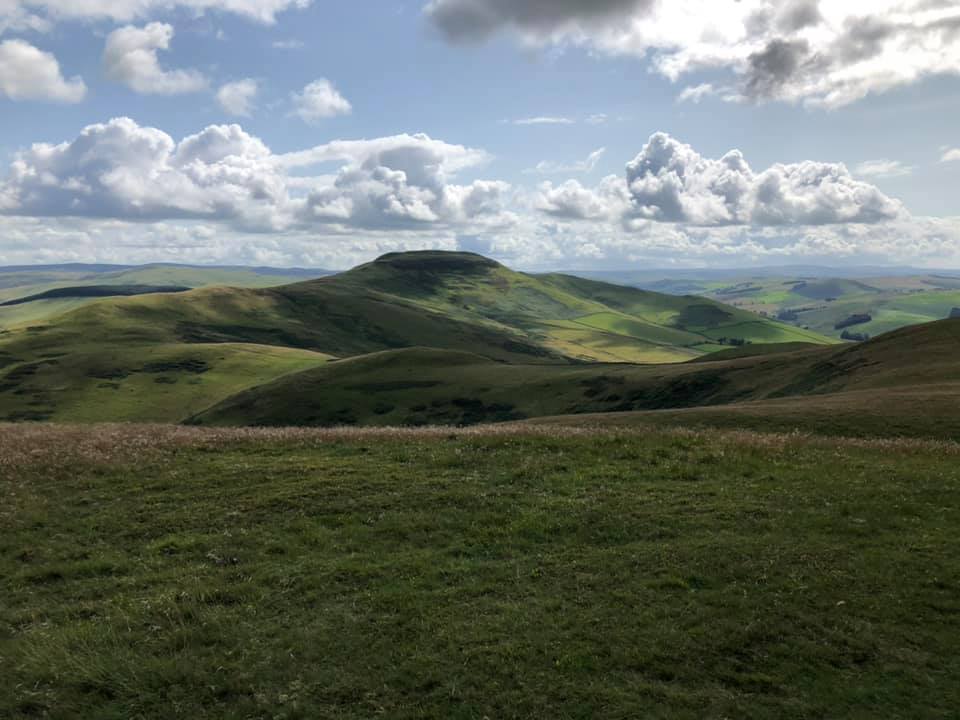
To read the world’s book, you must step out and walk. A story unfolds. The walker must tell it or sing it; the result is a joint creation that is both yours and the world’s. The anonymous Life of Cuthbert gives us a tiny glimpse of a musical procession along the banks of the River Tweed. Cuthbert had been invited to the village of a man called Sibba who lived somewhere beside the river. He arrived “with a company of people,” singing as they walked. They were singing psalms and hymns. A few years later, in 680, a herdsman called Caedmon would begin composing beautiful hymns in Old English, much to everyone’s surprise, including his own. Cademon was one of those people who are convinced that they can’t sing. Whenever party pieces were called for, Cademon would slip away. One night, he went out to the byre to feed the beasts and fell asleep there. A man came to him in his dreams, called him by name and asked him for a song. “I don’t know how to sing,” said Caedmon, “that’s why I left the feast.” “But you shall sing for me,” said the man. “What shall I sing about?” “Sing about the Creation of things,” said the man. And Caedmon began to sing—in his own voice—a song he had never heard before. On my pilgrimage, I fell in love with my song, my story, every day. It was far more compelling than any book. At night, I looked at the contents of my pack. I studied my jottings. I did not read actual books. They felt like a distraction from more important work.
On my first day out, twelve hours after I left Melrose to go over the Eildons, I wandered into the town of Jedburgh shattered. It was Sunday night, dark and raining lightly. The pubs weren’t serving food and, worst of all, I’d forgotten the name of the place I was staying. Panic set in. My bag had been delivered to the B&B whose name I’d forgotten. How would I find it? But my confusion—delirium even—came out of a total loss of concern about where I’d sleep or what I’d eat. And it was, I think, a sign that I was really truly on the way. There had been a moment along the old Roman road when I wanted to lay down in the deep grass, under the sacred protector tree (whose name remains a mystery) and pass the night in wonder. Perhaps I was living the parable of hidden treasure from Matthew 13: “The kingdom of heaven is like treasure hidden in a field. When a man found it, he hid it again, and then in his joy went and sold all he had and bought that field.” Even on my first day out, I knew that there was something challenging but immensely valuable about the project of pilgrimage, and it was even linked in some way to Jesus’ use of the parable as a teaching tool. What is the treasure hidden in the field? How is it comparable to the kingdom of Heaven? Jesus, who Cuthbert followed closely, walked, walked everywhere; and he, too, sought places of solitary prayer and contemplation. Perhaps even Jesus’s teaching grew out of the ecstasy of dreaming on foot. And maybe the kingdom of Heaven is knowing the field from the inside out … the topographic sublime.
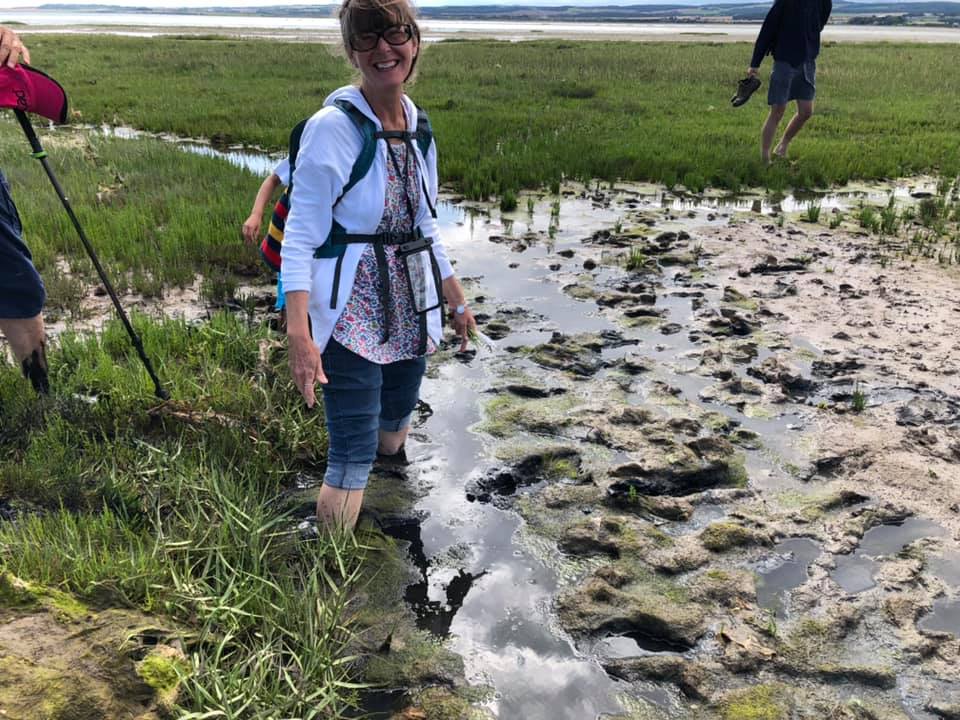
We Need Pilgrims to Walk in Flint
The landscape of Flint lends itself to pilgrimage because it is so richly storied and so ostensibly bleak. Walk through any decaying neighborhood and listen on the porches of abandoned houses. Knock on the door. Imagine the family on the night someone torched the house. There are lights on in some of the bungalows and pumpkins grimace on porch steps, but one in three houses remain dark. Where have all the workers gone? To reawaken the dead city, we must be like Basho (the Japanese poet wayfarer) who found tiny stories in each moment, following his own muse, the poet Saigyo, who could make a haiku of something very ordinary—a woman washing potatoes.
Saint Mary’s Church on Franklin Street, at the center of Flint’s east side, was founded in 1919 when most of the men in the neighborhood worked at Buick, just across the river. Then, Hungarians made and played cymbaloms in houses. Then, there was a rich life on Minnesota, Illinois, Iowa, New York, Delaware … a nation of workers and their families. Now the east side is a ghost town. “Why is a broken down fence more beautiful than a perfect one?,” asked one of my students in my “walking class,” when we wandered the dilapidated neighborhood around Thread Lake recently. Questions open the book of the world. Questions are the first step to feeling the desire to go further, to explore, to knock on doors.
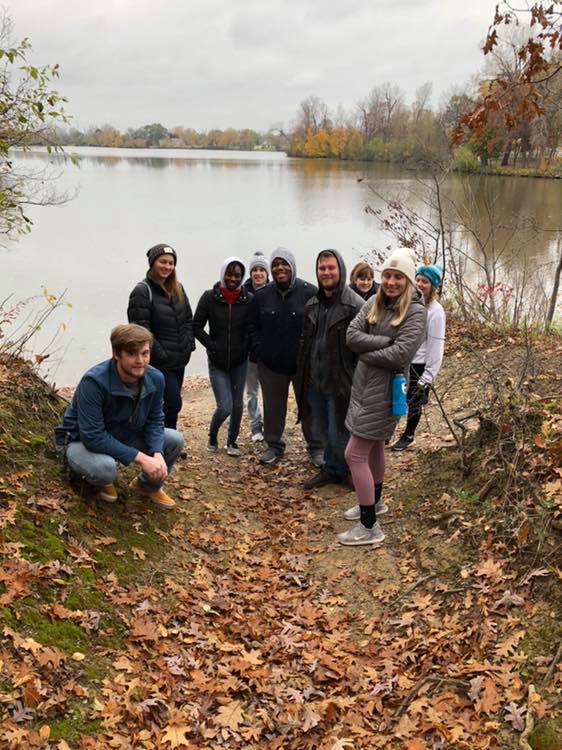
Every Sunday morning, I make a mini-pilgrimage from my home downtown to St. Mary’s on the east side. I head toward that neighborhood on weekdays, too. I go there when I’m out of inspiration. I go there when I can’t muster the ambition to drive to the woods. I go there because it’s easy and peaceful. I go there because no one will judge me. I go there to face the fact that I’m damaged and that life is damaged. I go there because I never know whether I’ll be moved to despair or joy: it can go either way.
Last time I walked the “state” streets, it was a good day. Gray. Against gray, the color of change, every hopeful thing stands out. I was thinking about my freshmen students’ initial reaction to seeing neighborhoods like this one. The ruins seemed to soften them, make them less judgmental, moved, as they were, to imagine the people who’d lived in these houses. Walking along, dreaming on foot, I saw a man in the distance, wearing a camo jacket and carrying a black plastic sack. Maybe he’s got a can of beer, I thought but didn’t indulge my fancy further, not wanting to turn this person into a character. As he approached, I saw that he was young and red-haired.
“Beautiful day, isn’t it?” he said brightly.
“Yes,” I said, “Yes, it IS a beautiful day.” Before he’d spoken to me, I wasn’t thinking that it was a beautiful day at all. It wasn’t a particularly beautiful day, but when he said that it was and said it TO ME, the day changed. I realized that it was warm, that it wasn’t raining, that it was late October and that the leaves were still to be enjoyed and that soon we’d have the oh so pretty early snow. There was so much to look forward to even in the poorest section of Flint.
Then Bryshon and his poem came into my mind. Bryshon is a young black man who stays at Whaley Children’s Center (an orphanage for kids who’ve already tried and failed in four or five foster families). Some of my students were doing a Shakespeare project there, and this person, who had been through so much trauma that he speaks in a whisper, volunteered to read a line from the Shakespeare play we are rewriting in a Flint setting. Standing next to him, he nudged me and pointed to a word on the index card. “Melancholy,” I said and repeated the word for him. “What’s that?” “Well, it’s like depression,” but I didn’t say is that it is so much softer, wider, deeper—infinite sadness. He shook his head as if he understood and read his line, “I can suck melancholy out of a song as a weasel sucks eggs.” Applause followed, and Bryshon smiled. He read the line two more times, each time a bit louder than the time before. Two weeks later, Bryshon told us about his Arden, his ideal place; and it is under the ground. But his underground world is full of life, burrowing animals and little bugs. He wrote about it in a poem that goes something like this:
The ground cracked,
But the soil is soft,
But the bark of a tee come down.
A bug bit up
And sky turn brown
Then the soil turn hard
Then the tree fall down the ground,
But the soil is always soft.
I love that line, “But the soil is always soft”—Mother Earth. So much has fallen and died on the east side of Flint. People have died in house fires. Families have split up due to drugs and alcohol. Mothers have been murdered. “Generous Motors” left town and abandoned all their little kiddos with no bread, no milk. There are “food deserts” all over Flint—that’s jargon for areas without grocery stores. The people left, understandably, to find work and to find nourishment. Here, holes remain where houses were. The soil is always soft. Porches sag and roofs cave in. Moss fills in the cracks. Ferns, the first plants to come back after mass extinctions, fill empty lots—ferns and weeds. Here, there were and are countless children who whisper because of all they’ve seen. I wonder how many of them, like Bryshon, who know what it feels like to fall, would still say, “the soil is always soft.”
Zen has a concept of “rusty beauty”—things that are beautiful because they are damaged. Life itself is damaged, and nothing which is perfect can be truly alive. Though I don’t fully understand why I am so drawn to neighborhoods like the east side of Flint, I know that they are much more alive than the track housing, malls, and fast food joints of Grand Blanc and Davison, where the population has grown in the last two decades by 200% while Flint has lost 100,000 people. People who live in the suburbs may have found material warmth and wealth—but the direct message of the heart is often less there. Poverty and dirt allow life to exist, allow life to shine out, because the middle-class conceptions of what is good are not at work killing it. “In the slum, in some way,” writes architect Christopher Alexander, “the direct voice of the heart is there.” It is there in the mud hut of an Indian village. It is there in the shacks built by squatters on the hills around Turkish cities. And it is there in the poor neighborhoods of Flint. It is life, the force of direct human experience, misery, compassion, ignorance, and warmth all mixed up together. It really is life.
Those of us who teach humanities must, it seems to me, go on pilgrimage and bring our students along. We must leave formal book work to read the books that are grazing in green lots and walking our city’s desolate streets. We must take our students out so that they are unafraid, so that they learn to learn from Others, so that they fashion public roles as citizens, but mostly so that they learn to read the world. But the books we’ve internalized, the books we’ve taught and keep teaching are also crucial because all the civic engagement in the world is no substitute for words like “melancholy” that work in the mind a change and for the human voice speaking those words, singing songs, and whispering poems. They are the fathom lines that plumb our depths, the ropes that drop buckets into our own personal wells. Inner Resources. A substitute for consumption and an antidote to boredom. We “literature” faculty have a crucial role but it’s a new one with new practices: the practice of walking the earth, the practice of paying attention, the practice of getting lost, the practice of listening to ruins.
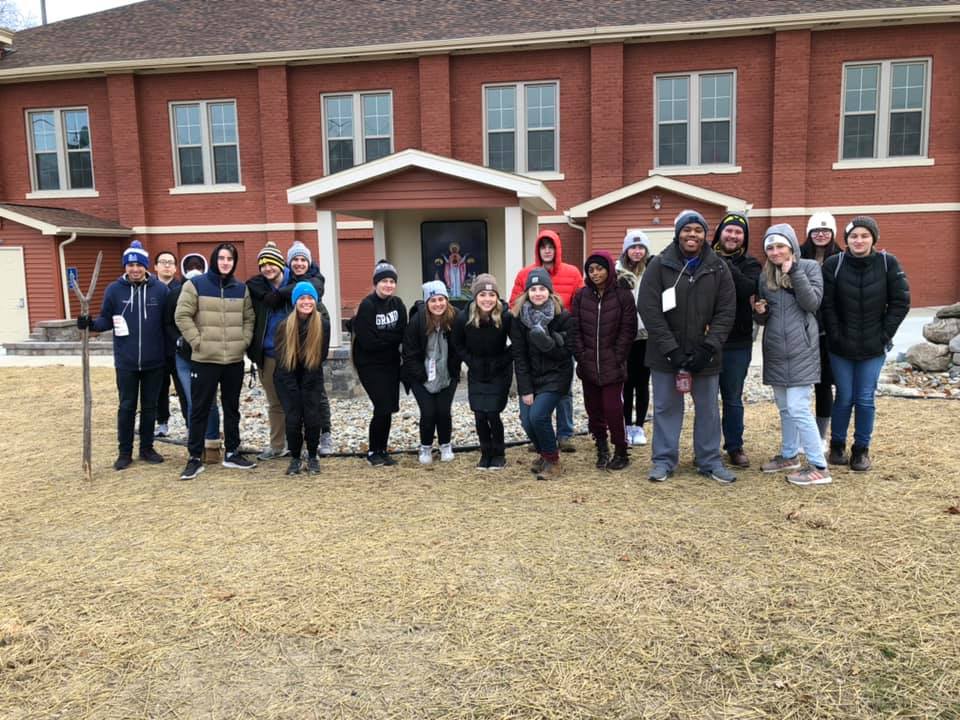
The trial run of my First Year Experience, The Literature and Practice of Walking, ends with a class pilgrimage to holy sites in Flint. Although the details have yet to be firmed up, the class has decided that we will walk for peace of mind and to bring awareness to the problems young people have with depression and anxiety. We will stand on our feet and walk in the cold on December 7th through the streets of a city that has been knocked down so many times and is struggling still to get back up. We’ve learned the story of Flint’s rise and fall, we’ve learned that Flint was a utopia for workers and birthplace of the UAW, and we understand that the city was vulnerable because it was little more than a company town. We know some of the heroes (sung and unsung). And we are beginning to think about our own life journeys and deep needs. We’ve plotted a pilgrimage route that connects places that resonate with us: the river, the murals on Lewis Street, the urban gardening in the empty lots on Jane Street, St. Mary’s Church with the African-American Mary icon who blesses Flint’s water, Kearsley Park where we will walk a labyrinth which some of the students and I will chalk out on the floor of the pavilion built in 1920. We’ll circle back to campus with a stop at the Flint Institute of Arts. On the way, we will pause often to reflect, write haiku, take photos, and drink hot chocolate from thermoses we plan to carry. Students will deposit three prayer stones at the places in the outer world that correspond with places in their hearts. Their final project will be to document the walk that they took; and all of us will compare journeys.

Class sizes may be shrinking, but I am not discouraged. We are on the way somewhere … to the new Jerusalem by way of a new Flint that we make up when we look each other in the eye, when we smile, when we talk and walk with others and use our unused voices. There will be saints, there will be cathedrals, there will be miracles, and, in the water crisis city, we will camp by 12 springs of water and seventy cottonwood trees.
by Dr. Mary Jo Kietzman, English Department
